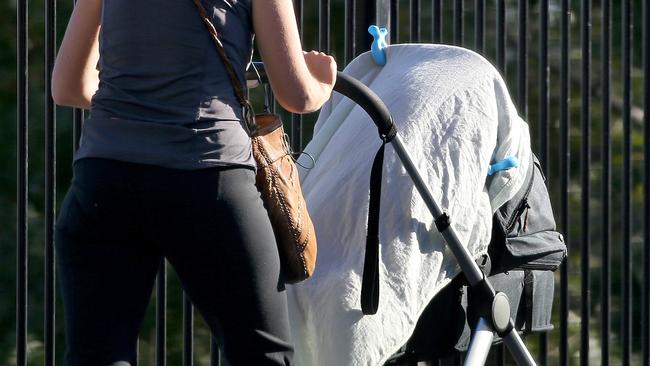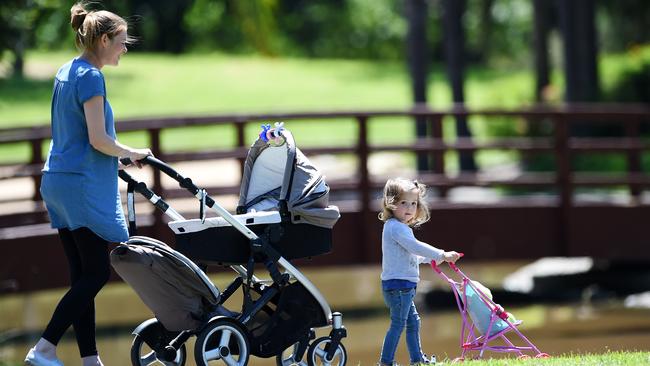Australian birth rate falls to record low
Australia’s birth rate has fallen to its lowest level on record, while the number of babies born was the lowest since 2006.

Economy
Don't miss out on the headlines from Economy. Followed categories will be added to My News.
Australia’s birth rate has fallen to its lowest level on record, as cost-of-living pressures continue to see couples delay having children into their 30s.
There were 286,998 births registered in Australia in 2023, a 4.6 per cent decrease from 2022 and the lowest since 2006, resulting in a total fertility rate of 1.5 babies per woman, according to data released by the Australian Bureau of Statistics (ABS) on Wednesday.
The fertility rate in Australia peaked at 3.55 in 1961 and has been plummeting ever since. Australia has been below replacement rate, or 2.1 babies per woman, since 1976.
“The record low total fertility rate is because there were fewer births in most states and territories,” ABS head of demography statistics Beidar Cho said in a statement.
Western Australia had the highest fertility rate of 1.57, followed by NSW and the Northern Territory (1.55), Queensland (1.54), South Australia (1.5) and Victoria (1.39).

The ACT had the lowest fertility rate of 1.31 babies per woman, while Tasmania was the only state or territory to record an increase, rising from 1.49 to 1.51.
“In 2023, the total fertility rate for mothers who were Aboriginal and Torres Strait Islander was 2.17 babies per woman,” Ms Cho said.
“There were 24,737 births registered where at least one parent was an Aboriginal and Torres Strait Islander Australian, which makes up 8.6 per cent of all births.”
The fertility rate has fallen from 1.86 in 1993 with the biggest declines seen in women aged under 24. By contrast, the fertility rate in the 40 to 44 age group has nearly doubled to 15.1 babies per 1000 women.
Women aged 30 to 34 continue to have the highest fertility rate of 105.2 babies per 1000, followed by women aged 25 to 29 on 74.9 babies per 1000.
“The long-term decline in fertility of younger mums as well as the continued increase in fertility of older mums reflects a shift towards later child-bearing,” Ms Cho said.
“Together, this has resulted in a rise in median age of mothers to 31.9 years, and a fall in Australia’s total fertility rate.”
Dr David Knox, an actuary and senior partner at consulting firm Mercer, said birthrates had been trending down globally for a number of years.

“Long-term birthrates have been falling for a whole combination of reasons,” he said.
“Women [are staying] in the workforce longer, taking more control of their reproductive decisions, it’s not assumed when you get married you have kids anymore, there’s a societal change that’s not only in Australia.”
More recently within Australia, the significant drop “reflects economic pressures” including the rising cost of housing.
“Having babies costs money, mortgages are costing more, so I think the cost-of-living pressures are causing people to put off having babies,” he said.
Dr Knox warned the trend posed significant challenges for the sustainability of Australia’s economy with fewer working-age people to pay the tax bill.
“We have an ageing population, you cannot rely as much as we were in the past for working-age people to be the only taxpayer,” he said.
“In decades to come there will be more people who are aged compared to working age, [which will have] implications for the broader taxation structure. The overall message is it’s going to cost us more in retirement than previously, so it’s important people save for their future.”
Dr Knox added that falling birthrates would mean “we are going to want skilled migrants in this country”.
“There will be increasing competition for skilled migrants around the world, whether it’s in Canada or the US or even China,” he said.
“I think it’s already a little bit pronounced in terms of what the government announced recently in fast-tracking doctors from the UK, Ireland and New Zealand. That’s just a signal of what might happen going forward. If there is a profession or skill we want in this country we will accelerate the migrant process.”
Originally published as Australian birth rate falls to record low





